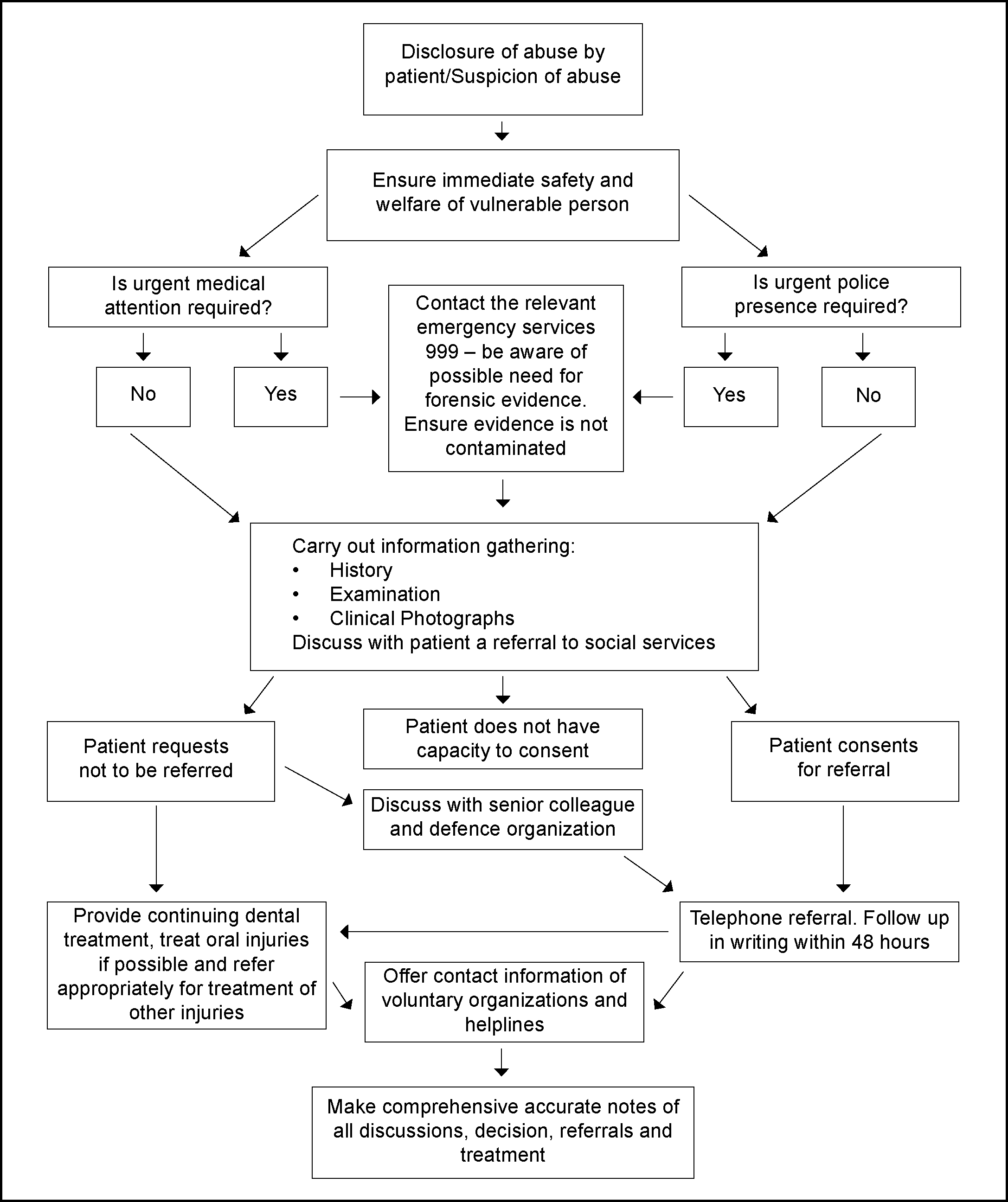GENERALGeneral signs
Appointments often missed
Poor compliance with treatment regimens
Explanations of injuries are conflicting or vague
|
Difficulties in arranging appointments/frequent cancellations
Injuries are inconsistent with explanation given
Delay in presentation for treatment of dental problems/injuries
|
Behaviour of patient
Appears passive or afraid of carer
Withdrawn/detached
Poor eye contact
Patient minimizes injuries
|
Remains quiet while carer responds to questions
Anxious
Closed body position/holding head down
|
Behaviour of carer
Attitudes of indifference or anger to the vulnerable adult
Care-giver not allowing the vulnerable adult to speak for him/herself
Care-giver blaming the vulnerable adult (eg for bad behaviour, incontinence, or forgetfulness)
|
Care-giver ignoring vulnerable adult
Inappropriate displays of affection by care-giver
Verbal intimidation, berating, or use of humiliating language by carer
Threats of punishment or deprivation
|
Features of the domestic environment
Lack of amenities, eg TV, personal grooming items
Soiled bed
Obvious absence of assistance or attendance
Obvious absence of protection, eg to prevent patient with severe dementia falling out of bed
|
Dirty, smelly, unsanitary conditions
Indications of unusual confinement, eg patient is closed off in a particular room, tied to furniture
|
PHYSICAL ABUSEGeneral signs
Cuts, lacerations, puncture wounds, open wounds, bruises, welts, discoloration, black eyes, burns, bone fractures, concussion
Untreated injuries in various stages of healing or not properly treated
Overdosing or underdosing of medication
|
Recognizable shape or pattern to bruises such as slap mark, bite mark, rope mark
Signs of restraint (visible restraint or bruising, eg rope marks)
Broken glasses
A vulnerable adult disclosing an experience of being hit, slapped, kicked or mistreated
|
Oro-facial signs
Lip trauma, fractured, subluxated or avulsed teeth, missing teeth
Bruising of the edentulous ridges or the facial tissues
Evidence of prior trauma to dental or oro-facial structures
|
Fractures of the mandible, maxilla or zygomaticomaxillary complex
Eye injuries, orbital fractures
Unexplained alopecia (from pulling hair)
Malnourishment, emaciation or dehydration without an illness-related cause
Failure to provide a safe environment
|
NEGLECTGeneral signs
Impaired skin integrity/ulcers, rashes, sores, lice, unkempt appearance, body odours
|
Soiled clothing or bed
Inappropriate clothing
Lack of appropriate physical aids such as glasses, hearing aids, assistance with eating and drinking
A vulnerable adult telling you he/she is left alone for long periods of time
|
Oro-facial signs
Poor oral hygiene, halitosis
Absence of dentures
Xerostomia
|
Rampant dental disease
Glossitis, angular cheilitis, other oral infections
|
PSYCHOLOGICAL ABUSE
Helplessness
Withdrawal, passive affect
Confusion or disorientation
Sudden change in behaviour
Depression
A vulnerable adult telling you they are being verbally or emotionally abused, is isolated, or left alone for days on end
|
Hesitation to talk openly, fearfulness
Denial of a situation
Anger without apparent cause
Emotionally upset or agitated
Unusual behaviour (sucking, biting, rocking)
|
FINANCIAL ABUSE
Lack of dental care
The vulnerable adult suffers from substandard care in the home, despite adequate financial resources
Signatures on cheques, etc that do not resemble the vulnerable adult's signature, or signed when the adult cannot write
Confusion of a vulnerable adult regarding his/her financial situation
|
Care-giver questions dentist on necessity of dental work for older person ‘at his age’
Disappearance of a vulnerable adult's possessions in an institutional setting
Vulnerable adult poorly dressed
The inclusion of additional names on an older person's bank account
Unpaid bills
A vulnerable adult telling you that someone has taken their money
|
SEXUAL ABUSE
A vulnerable adult telling you that they have been sexually assaulted or raped
|
Oral signs of sexually transmitted diseases, eg syphilitic or herpetic ulceration
Signs of psychological abuse (see above)
|


